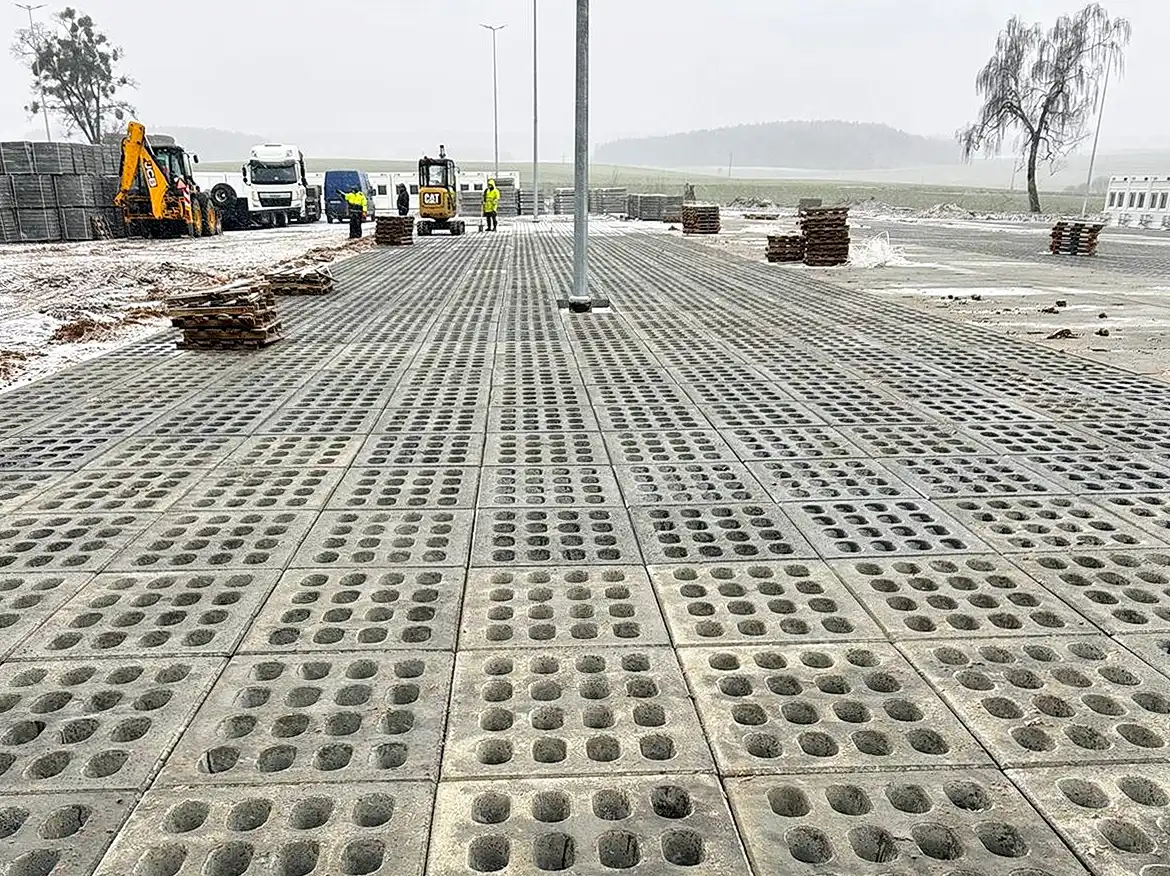Rapid Transformation of Land into a Modular Base
The pace of investment was relentless: heavy equipment was scheduled to arrive no later than the fourth week after the construction site handover. Traditional concrete pours were out of the question – the drying time was too long, and there was a risk of weather-related delays. Prefabricated concrete road slabs and military-tested Jomb slabs provided an advantage from day one. Instead of reinforcing and pouring concrete “in situ,” ready-made elements were brought to the site and could be assembled immediately after unloading.
The second key aspect is mobility. The structure, though planned for several years, must be dismantled without leaving a trace in the ground. Prefabricated elements meet this requirement one hundred percent: once the contract is over, they can simply be lifted and transported to a new location.
Prefabricated Elements to Meet Challenges – Why Concrete?
Although alternatives like composites or steel exist on the market, the heavy logistics of the investment and the required load-bearing capacity determined the choice of C35/45 class concrete. Concrete road slabs measuring 300 × 150 × 15 cm are the standard for constructing technological roads, storage yards, and foundations for modules. Their smooth, reinforced construction maintains integrity even under the pressure of several tens of tons per axle.
Meanwhile, Jomb slabs were designed for the rapid creation of landing pads, ramps, and reinforcements. Their characteristic lock-and-key joints allow them to bear significant dynamic loads, and when the gaps are filled with a sand-cement mixture, they achieve stiffness comparable to that of a poured foundation slab. As a result, unloading zones and maneuvering areas for heavy cranes received a surface that is difficult to criticize.
How We Laid Slabs Over 12,300 m² – Installation Insights
Logistical Organization
Each prefabricated element weighed nearly three tons, and more than a thousand square meters were delivered daily from trucks. A “just-in-time” schedule minimized storage needs: transport arrived, an HDS crane unloaded a pallet, and the assembly team immediately laid the elements on the prepared sand bedding.
Substructure Layers
Under each slab was 25 cm of stabilized sand, profiled with a 2% slope towards drainage ditches. This ensured that rainwater did not accumulate on the surface or undermine the surface from below. In the Jomb areas, an additional five-centimeter wedge belt of 2–8 mm aggregate was added, which, once sealed, created a uniform, resistant-to-shifting surface.
Quality Control
After laying each section, we conducted a load-bearing test using a VSS plate – results of 30–35 MPa confirmed that the surface could withstand even the heaviest modular cranes. For assurance, joint tightness was also checked to eliminate water accumulation in gaps.
Key Benefits for the Investor
-
Schedule Reduction – the installation of prefabricated elements lasted 18 working days, less than half the time needed for a traditional pour.
-
Operational Durability – C35/45 class concrete plus Jomb locks provide a load capacity of over 60 tons per axle, eliminating the risk of ruts or cracks.
-
Mobility and Material Recovery – after dismantling, the surface can be reused, significantly reducing the cost of subsequent investments.
-
Lower Environmental Impact – lack of deep ground disturbance and the ability to reuse slabs multiple times reduce the amount of construction waste.
-
User Safety – a smooth, weather-resistant surface minimizes the risk of slippage and container tilt.
Conclusions from the Construction Site and Recommendations
This project confirmed that the combination of concrete road slabs + Jomb slabs is the ideal strategy for projects requiring both high load-bearing capacity and short deadlines. Key is the combination of efficient logistics, precise ground compaction, and accurate jointing – then the surface “works” as a monolith, and its lifespan easily exceeds the planned operational time of the investment.
If you are planning a similar endeavor, remember that prefabricated elements not only save time but also offer greater flexibility at the project’s finish. They can be lifted, relocated, and reused at any time, which in today’s fast-changing construction world can be invaluable.
Check also: Concrete Road Slabs in Road Construction
Do You Have a Similar Project on the Horizon?
Contact us, and we’ll advise the best solution for your loads, schedule, and budget. We will create a complete plan – from design to delivery, assembly, and final approvals.


